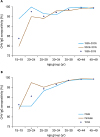1. Manicklal S, Emery VC, Lazzarotto T, Boppana SB, Gupta RK. The “silent” global burden of congenital cytomegalovirus. Clin Microbiol Rev. 2013; 26:86–102.

2. Lanzieri TM, Kruszon-Moran D, Amin MM, Bialek SR, Cannon MJ, Carroll MD, et al. Seroprevalence of cytomegalovirus among children 1 to 5 years of age in the United States from the National Health and Nutrition Examination Survey of 2011 to 2012. Clin Vaccine Immunol. 2015; 22:245–247.

3. Adler SP. Screening for cytomegalovirus during pregnancy. Infect Dis Obstet Gynecol. 2011; 2011:1–9.

4. Enders G, Daiminger A, Lindemann L, Knotek F, Bäder U, Exler S, et al. Cytomegalovirus (CMV) seroprevalence in pregnant women, bone marrow donors and adolescents in Germany, 1996–2010. Med Microbiol Immunol (Berl). 2012; 201:303–309.

5. Antona D, Lepoutre A, Fonteneau L, Baudon C, Halftermeyer-Zhou F, LE Strat Y, et al. Seroprevalence of cytomegalovirus infection in France in 2010. Epidemiol Infect. 2017; 145:1471–1478.

6. Stoykova ZD, Ivanova LI, Todorova TT. The role of cytomegalovirus in congenital and early postnatal infections in Northeastern Bulgaria. Folia Med (Plovdiv). 2017; 59:298–302.

7. Jin Q, Su J, Wu S. Cytomegalovirus infection among pregnant women in Beijing: seroepidemiological survey and intrauterine transmissions. J Microbiol Biotechnol. 2017; 27:1005–1009.

8. Pancharoen C, Bhattarrakosol P, Thisyakorn U. Seroprevalence of cytomegalovirus infection in children. Southeast Asian J Trop Med Public Health. 1998; 29:269–272.
9. Wong A, Tan KH, Tee CS, Yeo GS. Seroprevalence of cytomegalovirus, toxoplasma and parvovirus in pregnancy. Singapore Med J. 2000; 41:151–155.
10. Shigemi D, Yamaguchi S, Otsuka T, Kamoi S, Takeshita T. Seroprevalence of cytomegalovirus IgG antibodies among pregnant women in Japan from 2009–2014. Am J Infect Control. 2015; 43:1218–1221.

11. Chen MH, Chen PC, Jeng SF, Hsieh CJ, Su FC, Liao HF, et al. High perinatal seroprevalence of cytomegalovirus in northern Taiwan. J Paediatr Child Health. 2008; 44:166–169.

12. Oh YC, Choi BR, Kim CA, Cho MJ. A study for detection of IgG, IgM antibody to cytomegalovirus in blood donors. Korean J Hematol. 1989; 24:75–79.
13. Park HK. Study of cytomegalovirus and herpes simplex virus antibodies in Korean pregnant women with complement fixation test. Ewha Med J. 1984; 7:191–197.

14. Seo SY, Park SJ, Hwang JY, Hahn SH, Kim SY, Kim HH, et al. The Alteration of the positive rate of cytomegalovirus IgG antibody among preschool period children. Korean J Pediatr. 2006; 49:51–55.

15. Lee KY. Seroepidemiology of cytomegalovirus in Taejon, Korea, in 1996. J Korean Pediatr Soc. 1998; 41:754–759.
16. de Ory F, Ramírez R, García Comas L, León P, Sagües MJ, Sanz JC. Is there a change in cytomegalovirus seroepidemiology in Spain? Eur J Epidemiol. 2004; 19:85–89.

17. Takemoto K, Nishimura N, Kozawa K, Hibino H, Kawaguchi M, Takeuchi S, et al. Time-series analysis comparing the prevalence of antibodies against nine viral species found in umbilical cord blood in Japan. Jpn J Infect Dis. 2016; 69:314–318.

18. Korean Statistical Information Service (KOSIS). Population by census. Daejeon: Korean Statistical Information Service;2015.
19. Puhakka L, Renko M, Helminen M, Peltola V, Heiskanen-Kosma T, Lappalainen M, et al. Primary versus non-primary maternal cytomegalovirus infection as a cause of symptomatic congenital infection - register-based study from Finland. Infect Dis (Lond). 2017; 49:445–453.

20. Kim CS. Congenital and perinatal cytomegalovirus infection. Korean J Pediatr. 2010; 53:14–20.

21. Voigt S, Schaffrath Rosario A, Mankertz A. Cytomegalovirus seroprevalence among children and adolescents in Germany: data from the German Health Interview and Examination Survey for Children and Adolescents (KiGGS), 2003–2006. Open Forum Infect Dis. 2015; 3:ofv193.

22. Taniguchi K, Watanabe N, Sato A, Jwa SC, Suzuki T, Yamanobe Y, et al. Changes in cytomegalovirus seroprevalence in pregnant Japanese women-a 10-year single center study. J Clin Virol. 2014; 59:192–194.

23. Shim YG. Complement-fixing antibodies against Cytomegalovirus among volunteer blood donors in Seoul area. Korean J Epidemiol. 1981; 3:99–104.
24. Cho YK, Shim TS. Antibody positive rate in primary school children against cytomegalovirus as detected by ELISA method. Chung Ang J Med. 1982; 7:407–411.
25. Kim CH, Shim TS. Antibody posses rate of schoolgirls against rubella and cytomegalovirus by ELISA method. Chung Ang J Med. 1982; 7:247–252.
26. Baek SG, Shim TS. Antibody positive rate of cytomegalovirus by ELISA in preschool children. Off J Res Med Sci Korea. 1986; 18:46–50.
27. Sohn YM, Park KI, Lee C, Han DG, Lee WY. Congenital cytomegalovirus infection in Korean population with very high prevalence of maternal immunity. J Korean Med Sci. 1992; 7:47–51.

28. Lee HJ, Jang SH. Prevalence of antibody to cytomegalovirus by anticomplement immunofluorescence test in Korean children. Korean J Infect Dis. 1993; 25:357–361.
29. Kim YK, Kim DW. Seroepidemiology of human cytomegalovirus in healthy adults measured by means of the anticomplement immunofluorescence technique. Korean J Infect Dis. 1992; 24:87–92.
30. Seo S, Cho Y, Park J. Serologic screening of pregnant Korean women for primary human cytomegalovirus infection using IgG avidity test. Korean J Lab Med. 2009; 29:557–562.








 PDF
PDF ePub
ePub Citation
Citation Print
Print





 XML Download
XML Download